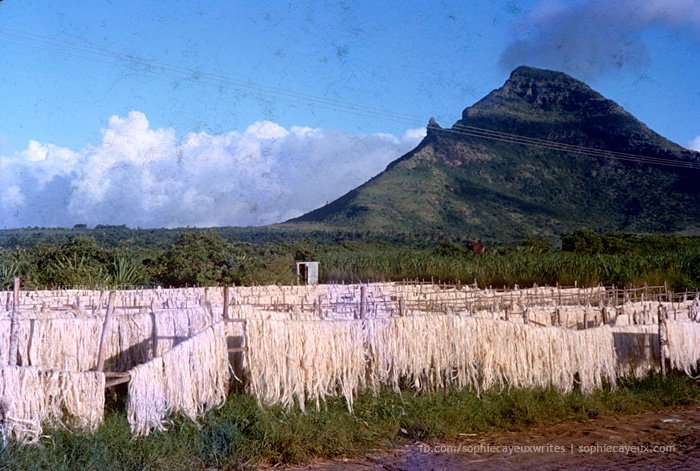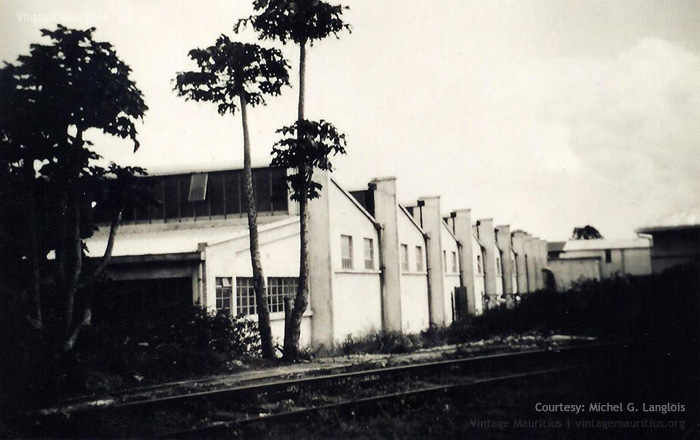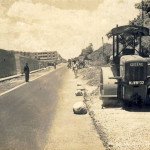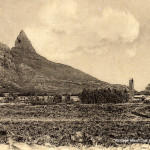
Aloe Fibres Drying in Sun at La Ferme – Mauritius – 1968
Aloe Fibres have been used quite extensively in Mauritius during the past years for the creation of ‘Goni’ (Gooni) bags. Before the advent of polypropylene and plastic bags, goni was an indispensable element in the overall trade, not only in Mauritius, but throughout the world. It was used to pack and ship agricultural commodities such as rice, wheat, coffee, potatoes, sugar, fertilizer and salt. Made from natural fibres, the high breathability of goni allowed air to pass through them and helped packaged agricultural commodities to stay fresh.
In Mauritius, the demand for goni was intricately linked with sugar trade. Until such time when we started exporting sugar in bulk, goni was the traditional means of packing and transporting this commodity. The local production of goni from aloe fibre being inadequate, Mauritius had to rely heavily on imported gunny bags made of jute-fibres. They were sourced mainly from West Bengal and East Pakistan (known as Bangladesh today). Nonetheless, there was always some shortfalls or demand urgencies which were met by having recourse to used goni. The increased demand for goni was therefore a barometer that could reflect the buoyancy in sugar production in a given year. Image above depicting the process of the aloe fibre being dried in the sun somewhere near La Ferme. Image courtesy: Sophie Cayeux

Goni Bag Factory – Quatre Bornes – Mauritius – 1950s
The no-more Goni Bag Factory (picture above) was found at end of Avenue Victoria in Quatre Bornes and at that time we could still see the railway line passing by the factory. Image courtesy of: Michel G. Langlois
There is an interesting anecdote of a goni dealer who became a business tycoon in the early 20th century. An Indian immigrant landed bare-footed and penniless at the port of Mombassa. He started as marchand goni to earn a living. Having a sense of business flair, he quickly understood how he could make millions out of goni bags. His problem was how to collect millions of used goni bags daily. He had the brilliant idea of buying a huge volume of potatoes packed in gunny bags from the auction and wholesale them to several distributors at practically the same price he bought them. This made several distributors flock to him. The only condition he imposed was that the used goni be returned to him. Very quickly he acquired the monopoly of goni business in his area and with the huge profits amassed from this activity he laid the foundation for a diversified business for his posterity. Today, his descendants possess a network of flourishing business and industries all over East Africa and in the Indian Ocean.
“Goni vid pa kapav dibout”
Goni, apart from being used for packing commodities, was well-entrenched in the Mauritian tradition. It had a myriad of uses. It served as mattress for both the indentured labourers and the African slaves. The sugar-cane cutters used to wrap it around their waist up till their knees and also wore “souliers goni” in order to protect their legs and feet against sharp sugar-cane leaves. The dockers used to cover their heads to avoid deposit of dust on their hair and shoulders. The underprivileged utilized it as blanket to warm themselves in cold winters. Children in olden days used goni for sack-racing in their schools’ sports competition. The bhandari (chef in biryani) used it as apron when handling the deg (large traditional cauldron) on flaming fire. It also gave rise to a Mauritian proverb which goes like that “Goni vid pa kapav dibout” (Empty gunny bag cannot stand on its own).
Goni was also used to store old documents, outdated household items, artefacts and family objects of the previous generation. This old sack, for which nobody had any use anymore, would remain stacked for several years unnoticed in the machaan (mezzanine store) of the house until alerted by the attack of termites. In his novel “The Gunny Sack”, M.G. Vassenji, the Commonwealth Writers Award Winner, immortalizes the last memories of a family coming out of the gunny sack. “Salim Juma, in exile from Tanzania, opens up a gunny sack bequeathed to him by a beloved great-aunt. Inside he discovers the past – his own family’s history and the story of Asian experience in East Africa. Its relics and artefacts bring with them the lives of Salim’s Indian great grandfather, Dhanji Govindji, his extensive family and all their loves and betrayals”.
Goni had once been deep-rooted in the socio-economic fabric of Mauritius. It was not only a commodity prized by the sugar oligarchy, but a companion of all seasons in the routine life of Mauritians of all background. Today, it has been dethroned by plastic bags. The present generation does not seem to have any idea of how goni had once been an integral part of the Mauritian tradition. It is incumbent upon the custodians of our patrimony and museum to preserve the specimen, artefacts, folklore and tradition about goni and retrieve the last vestiges of goni industry. It is regrettable that the ruins of the old aloe factory at Trou-aux-Biches have disappeared under the sway of morcellement and spatial development. The relics could have been spared, not only for tourist attraction, but for reminding the present generation and posterity about the canvas and contours of our socio-economic history.
Marchands goni (collectors of gunny sacks) have disappeared from the Mauritian folklore. On surface it would appear to be a trivial trade, but indeed it had strong ramifications in the Mauritian society. The marchands goni used to go from shop to shop and house to house to collect used gunny sacks and sell them to large firms which badly needed them to pack their goods. Many people willing to get rid of the used sacks from their store, would give them away for free to the marchands goni. Very few could imagine that such an inexpensive commodity was, in fact, a lucrative business which created millionaires.
At a time when “Maurice Ile Durable” is high on our agenda, we have made it a national priority to get rid of plastic bags which are encroaching upon our environment. With some creative imagination, the goni can be re-styled in smaller format as user-friendly bags to replace the plastic bags. Given its high tensile strength, carrier-bags made of goni can be used as tente bazaar and can be washed, dried and re-utilized several times until they become worn-out. They are non-carcinogenic, non-toxic and biodegradable. May be we need a new breed of marchands goni to popularize the stylish and intelligent use of “sacs goni” in the supermarkets and bazaars.
Source: Le Mauricien
Author: Assad Bhuglah





